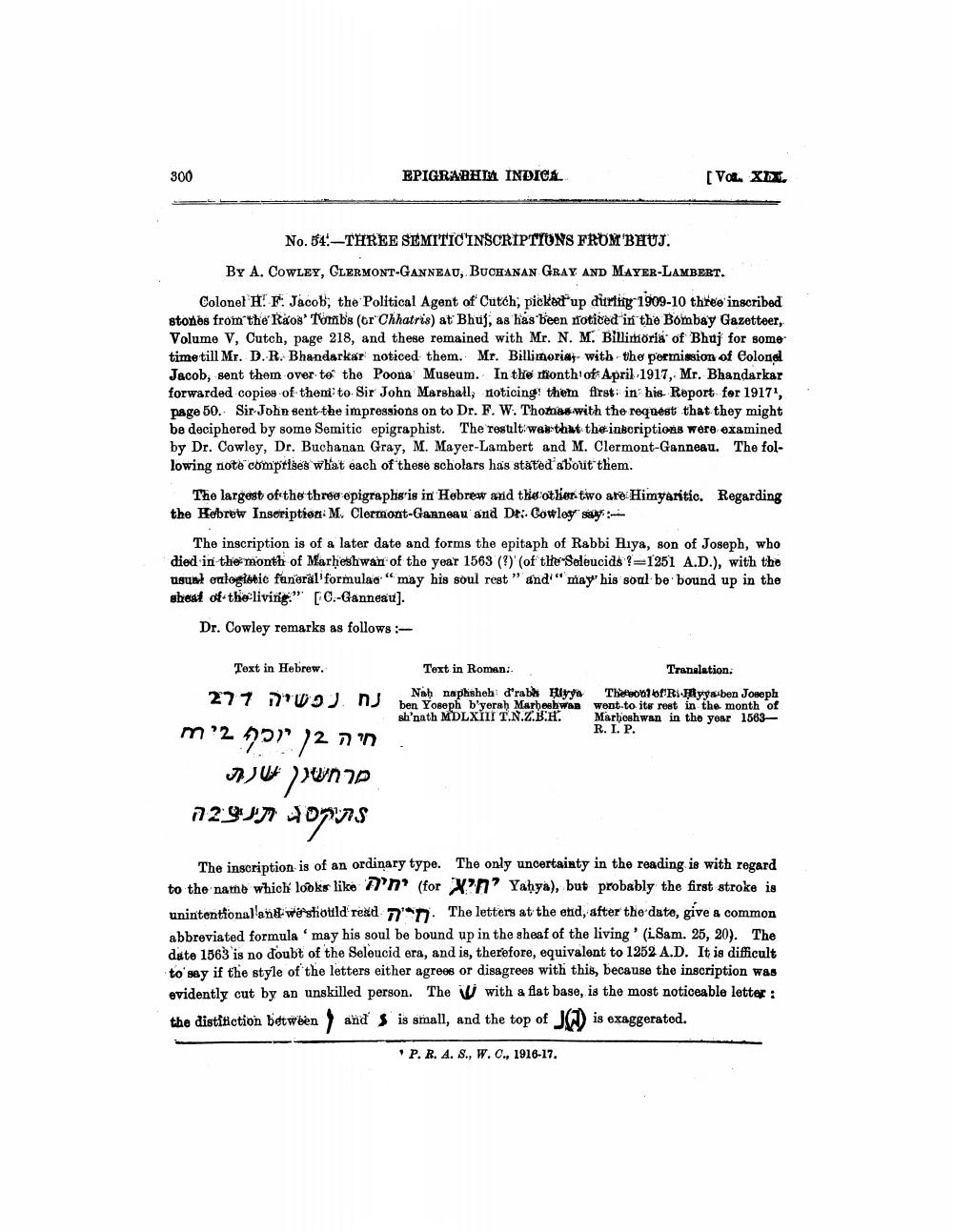________________
300
EPIGRARHM INDICA
[Vol. XX.
No.54:-THREE SEMITIC'INSCRIPTIONS FROM'BHUJ. By A. COWLEY, CLERMONT-GANNEAU, BUCHANAN GRAY AND MAYER-LAMBERT. Colonel HF Jacob, the Political Agent of Cutch, picked up durtig 1909-10 three inscribed stones from the Rios Tombs (tr" Chhatris) at Bhuj, as has been foticed in the Bombay Gazetteer, Volume V, Cutch, page 218, and these remained with Mr. N. M. Billimoria of Bhuj for some time till Mr. D. R. Bhandarkar noticed them. Mr. Billimoria with the permission of Colonel Jacob, sent them over to the Poona Museum. In the month of April 1917, Mr. Bhandarkar forwarded copies of theni to Sir John Marshall; noticing the first in his Report for 1917, page 50. Sir John sent the impressions on to Dr. F. W. Thomas with the request that they might be deciphered by some Semitic epigraphist. The result was that the inkoriptions were examined by Dr. Cowley, Dr. Buchanan Gray, M. Mayer-Lambert and M. Clermont-Ganneau. The following note comprises what each of these scholars has stated about them.
The largest of the three epigrapherie in Hebrew and the other two are Himyaritic. Regarding the Hebrew Inscription: M. Clermont-Garneau and De: Cowley say.
The inscription is of a later date and forms the epitaph of Rabbi Hiya, son of Joseph, who died in the month of Marheshwant of the year 1563 (O) (of the Seleucids ? =1251 A.D.), with the usunk onlogistic funeral formulad"may his soul rest " and "may his soul be bound up in the sheat of the living."" [C.-Ganneau).
Dr. Cowley remarks as follows:
Text in Roman:
Translation. Nah naphsheh d'ra bih Hlyga TheolofRHyya ben Joseph ben Yoseph b'yerah Marbeobwae went to its rest in the month of sh'nath MDLXIII T.N.Z.B.H. Marhoshwan in the year 1563
R.I.P.
Text in Hebrew. 277 DVI nj m’200112 nn
AJU MUND 1291N 079s
The inscription is of an ordinary type. The only uncertainty in the reading is with regard to the name which looks like 'n' (for X?n? Yahya), but probably the first stroke is unintentionallanwestould read 7 7 . The letters at the end, after the date, give & common abbreviated formula 'may his soul be bound up in the sheaf of the living' (i.Sam. 25, 20). The date 1563 is no doubt of the Seleucid era, and is, therefore, equivalent to 1252 A.D. It is difficult to sey if the style of the letters either agrees or disagrees with this, because the inscription was evidently cut by an unskilled person. The with a flat base, is the most noticeable letter : the distitction between and' s is small, and the top of J is exaggerated.
P. R. A. S., W.O., 1916-17.




